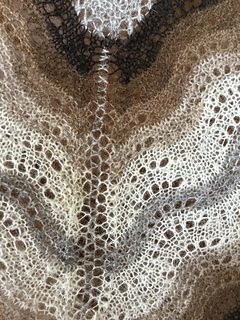Published: 03 June 2018
Hap from Foula wool
 Hap on a hap board
From the time I was very young I saw my aunt, Annie, who shared our family home, knit haps. I grew up knowing how she knit them and I had knitted mini-haps for workshops so I could share how to construct them. However I never had the inclination to knit a large hap myself, until last month.
Hap on a hap board
From the time I was very young I saw my aunt, Annie, who shared our family home, knit haps. I grew up knowing how she knit them and I had knitted mini-haps for workshops so I could share how to construct them. However I never had the inclination to knit a large hap myself, until last month.
A few years ago Foula Wool started to have their wool spun into double knitting yarn - I wrote about one of my visits to Foula here. At the Makers' Market during Shetland Wool Week 2017, I spoke with Magnus who had just got a batch of wool spun into laceweight yarn - to get it to the market he'd had to collect the parcel from the post office that morning. Lace is not my first choice of knitting so I forgot I'd ever seen it. By chance I met Magnus's partner last month and she asked if I would like to try knitting with their laceweight yarn. I was about to make a trip to England so it seemed a good idea to take some laceweight yarn for the journey and I got 25g of each of the 7 undyed colours.
 Edging
I decided to make a biggish hap, but forgot to take anything other than 'wires an wirsit' (needles and wool). Needles were 2.5 mm - thicker needles would have given a bigger, more floaty hap but that is less robust and it's easier to snag a thread. The hap is knitted in the traditional way, starting with the narrow lace edging. As I'm not an experienced lace knitter I don't have any edging patterns stored in my head so I created a couple of narrow edgings, one of which I used for the hap. It's 18 rows for each repeat - I think it took 5-6 minutes for each repeat. I guessed how long it should be and ended up with 84 repeats, 21 for each side.
Edging
I decided to make a biggish hap, but forgot to take anything other than 'wires an wirsit' (needles and wool). Needles were 2.5 mm - thicker needles would have given a bigger, more floaty hap but that is less robust and it's easier to snag a thread. The hap is knitted in the traditional way, starting with the narrow lace edging. As I'm not an experienced lace knitter I don't have any edging patterns stored in my head so I created a couple of narrow edgings, one of which I used for the hap. It's 18 rows for each repeat - I think it took 5-6 minutes for each repeat. I guessed how long it should be and ended up with 84 repeats, 21 for each side.
 Unblocked border pattern
Stage 2 is to knit ‘da board’ - the border which has mitred corners. This is done by making stitches from the straight edge of the lace - slipping the stitch at the start of every row at the straight edge is an easy way to make these stitches. Traditionally this part was often done in either one or two parts (the whole or half), worked back and forth, so only one or two corner(s) had to be joined. As knitting was done, the corners were shaped, and a 'stik' (a column of holes) was usually knitted to mark each corner. The challenge of knitting either as a whole or in 2 halves is to sew the remaining corners well enough to match the knitted corners. I wasn't confident that I could do that so I opted to knit 4 separate quarters, using the "aald shell" pattern to give waves of the natural colours. The stitches of one quarter fitted nicely on to my 40 cm double pointed needles (I much prefer straight needles to circulars). This meant I had more ends to weave in but I should get all corners to look exactly the same. I could knit a length of edging, then knit a quarter, before returning to knit more edging - that helped relieve the tediousness. By the time I had all four quarters knitted I was back home so I referred to Zena’s instructions in A Legacy of Shetland Lace and looked at the old haps knitted by my aunts before knitting the middle square. I opted to follow Zena's way and put all quarters together to knit (back and forth) 2 rows - 1 decrease row and a 2 row lace pattern. Next I put one quarter on hold (a great use for a circular needle). I used the stitches from the opposite quarter to knit the middle, joining the side quarters as I knitted. As I wanted the centre to be one colour I need more of the grey yarn - in total I used about 60g of grey.
Unblocked border pattern
Stage 2 is to knit ‘da board’ - the border which has mitred corners. This is done by making stitches from the straight edge of the lace - slipping the stitch at the start of every row at the straight edge is an easy way to make these stitches. Traditionally this part was often done in either one or two parts (the whole or half), worked back and forth, so only one or two corner(s) had to be joined. As knitting was done, the corners were shaped, and a 'stik' (a column of holes) was usually knitted to mark each corner. The challenge of knitting either as a whole or in 2 halves is to sew the remaining corners well enough to match the knitted corners. I wasn't confident that I could do that so I opted to knit 4 separate quarters, using the "aald shell" pattern to give waves of the natural colours. The stitches of one quarter fitted nicely on to my 40 cm double pointed needles (I much prefer straight needles to circulars). This meant I had more ends to weave in but I should get all corners to look exactly the same. I could knit a length of edging, then knit a quarter, before returning to knit more edging - that helped relieve the tediousness. By the time I had all four quarters knitted I was back home so I referred to Zena’s instructions in A Legacy of Shetland Lace and looked at the old haps knitted by my aunts before knitting the middle square. I opted to follow Zena's way and put all quarters together to knit (back and forth) 2 rows - 1 decrease row and a 2 row lace pattern. Next I put one quarter on hold (a great use for a circular needle). I used the stitches from the opposite quarter to knit the middle, joining the side quarters as I knitted. As I wanted the centre to be one colour I need more of the grey yarn - in total I used about 60g of grey.
 The part I was dreading was joining the corners but I found using what I call ‘Betsy’s join’ made it easy and weaving in the ends wasn’t too tedious - with such a sticky yarn the ends don’t have to be woven very far. After sharing photos on Instagram, someone recommended using a felting needle to secure ends in fine lace knitting - seems like a good suggestion. ‘Betsy’s join’ is demonstrated in 50 Tips from Shetland Knitters.
The part I was dreading was joining the corners but I found using what I call ‘Betsy’s join’ made it easy and weaving in the ends wasn’t too tedious - with such a sticky yarn the ends don’t have to be woven very far. After sharing photos on Instagram, someone recommended using a felting needle to secure ends in fine lace knitting - seems like a good suggestion. ‘Betsy’s join’ is demonstrated in 50 Tips from Shetland Knitters.
Undressed (unblocked) each side measured just 60 cm. Before washing I used a blunt needle to pass strong cotton through each point of the lace, making sure the cotton was longer than I'd need. I washed the hap in hand hot water, using Wool Wash from Shetland Soap Company, a social enterprise and charity which provides employment and skill development for adults with learning disabilities. My very old hap board is adjustable and the smallest size is 90 cm which is a perfect fit. That must mean that long ago haps this small must have been made. When stretching it I tightened all the blocking threads till the middle of the hap bounced back at me when I poked it. On the board the hap is measuring 87cm. It stayed on the board for about 28 hours. Although it was dry long before that, it's best to give the wool time to remember what you want it to do! After coming off the board it's been relaxing and now measures 80 cm, and weighs under 120 grams.
I loved knitting with this yarn which has quite a lot of oil in it, and smells sheepy. It didn’t break at all - I am always nervous about k3tog in thin yarn but this is strong enough to cope, and I had no breakages when I 'dressed' (blocked) it. I always think 'dress' is a much more appropriate word than 'block' as it's clear from the photos how much lace knitting needs to be dressed before appearing in public.
 Hap on board
Hap on board
I have started to write the pattern.
I was given this yarn to try but I will happily buy more and have plans for what I will knit with what I have left.
Subscribe for Updates
Enter your email address to receive updates from hazeltindall.com in your inbox...
About Shetland

Shetland is the most northerly group of Scottish islands. Apart from mainland Scotland, the other near neighbours are Norway to the east and the Faroe Islands to the north west.











